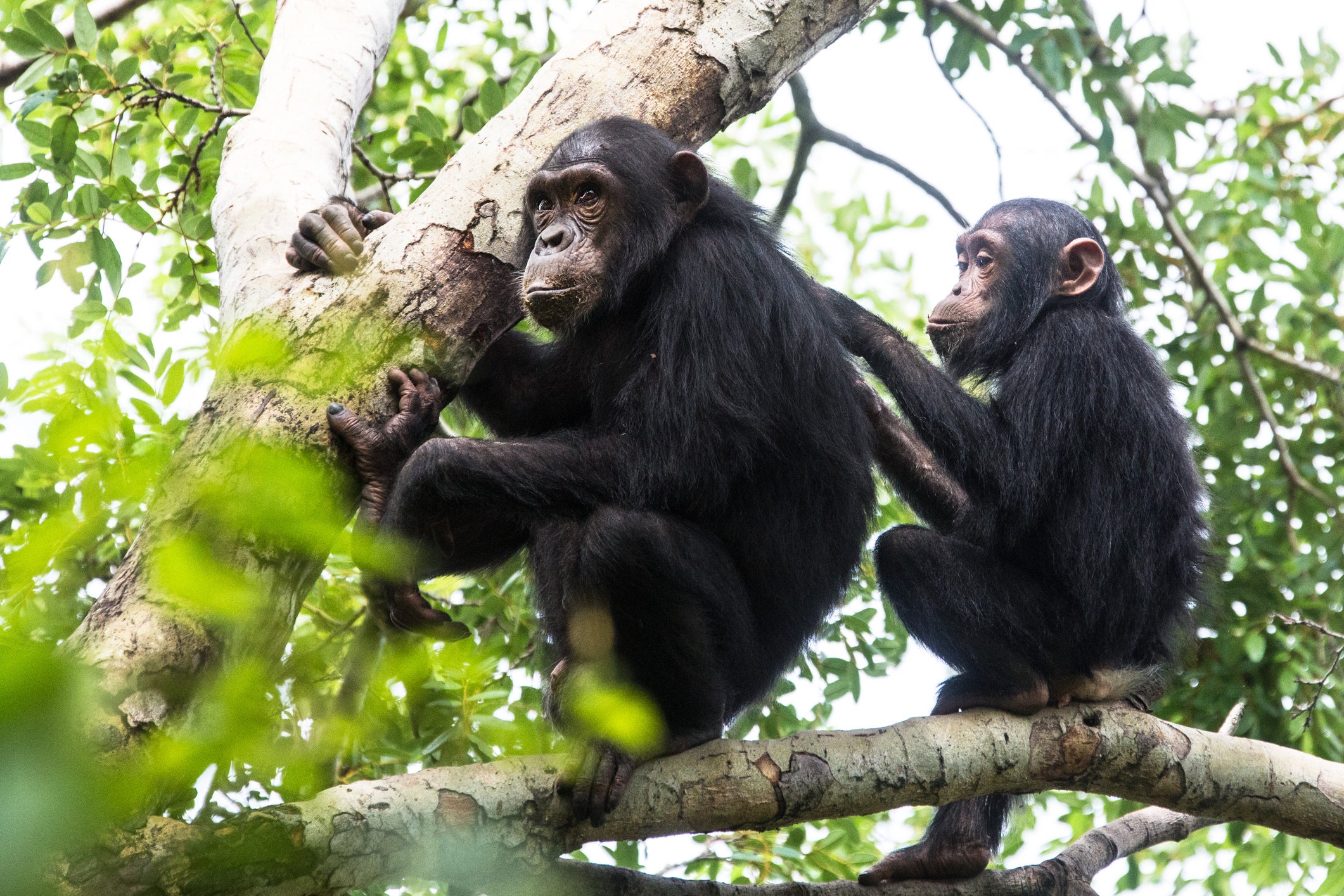Why do humans laugh?
More than just making you feel wonderful, laughter has played an important evolutionary role for Homo sapiens, writes Sean T Smith


When was the last time you really laughed? Not a wry chuckle, a knowing chortle or even a throaty guffaw, but the sort of undignified spasm that crumples you double, forcing the air from your lungs in a volley of convulsive waves?
According to the eminent evolutionary psychologist Robin Dunbar, laughter helps to explain who we are and where we’ve come from.
Howling with laughter makes you feel that you’ve lost control of yourself because in a sense you have. An ancient evolutionary impulse has taken possession of your respiratory system; it’s squeezing your diaphragm and the muscles between your ribs so hard that air is being evacuated through your lungs and larynx at a rate and force you couldn’t deliberately replicate if you tried.
You can hardly breathe, let alone talk. For a second, you fear you might even die. As you try to regain your breath, you suffer a setback: now, the shoulders of the people around you are also rocking. Real laughter is wildly contagious.
And it feels so good. Your body has been flooded with endorphins and other bliss hormones that will leave your mood elevated long after you’ve recovered your composure.
It is the rarity of contagious, gale-force laughter that makes it so memorable. Chances are you’ll cherish that memory for a long time. It’s likely that, at the very least, you trust the companions who shared that experience – but it’s far more likely that you’re truly fond of them.
That’s very much the point of laughter, according to Professor Dunbar, emeritus professor of evolutionary psychology at the University of Oxford: it cements new social bonds and deepens existing ones.
Prof Dunbar explains that the fact that we share this involuntary laughing impulse with the great apes suggests that it emerged as a social bonding behaviour long before our ancestors were able to talk to each other.

“If someone starts laughing it’s very difficult not to join in,” he tells me. “It has all the hallmarks of something that’s very old and not something we consciously think about.”
Prof Dunbar is perhaps best known for making the number 150 famous. Primate communities tend not to grow beyond a species-specific size limit, because when that point is breached the wider group dynamic breaks down and the troupe splits into rival cliques. Dunbar has discovered a strong correlation between primate brain size and the average size of the social groups they are able to maintain.
Gorillas and chimpanzees tend to live in groups averaging 20 or 30 members, for example. By using the volume of the average human brain and extrapolating upwards, he has estimated that modern humans have a “Dunbar number” of 150.
If there is a cognitive limit to the number of people with whom we can maintain stable social relationships, it might explain not only why 150 might feel like the optimum size for a secondary school year group, a military regiment or a rural village community – but where human laughter came from.
Laughing triggers an endorphin response that’s very similar to that stimulated by grooming. But the fact that human laughter is so unusually loud is perhaps an even more suggestive clue
Primates form social bonds and alliances by grooming each other. But grooming is a time-consuming and labour-intensive process that can only be done on a one-to-one basis.
Our ancient hominin ancestors developed much bigger brains around 2.5 million years ago, at the same time as they started to live in larger communities that must have had a more complex social structure.
At that point, Prof Dunbar believes, there wouldn’t have been enough hours in the day to maintain relationships through physical grooming alone.
“Primates spend 20 per cent of the daytime grooming,” he says. “This imposes an upper limit – a kind of glass ceiling of around 50. Social group sizes tend not to grow beyond that unless you solve the bonding problem in some other way.”
Prof Dunbar believes that laughter was evolutionarily co-opted to fill that gap. He explains that laughing triggers an endorphin response that’s very similar to the one stimulated by grooming. But the fact that human laughter is so unusually loud is perhaps an even more suggestive clue.
“Laughter comes from very old monkey and ape behaviour, namely the play-grunts that are very common among the sociable monkeys and the great apes,” he says. “African great apes produce sounds that are easily recognisable as laughter. Their pant-like grunt alternates between inhaling and exhaling, which makes it quite quiet. Human laughter is essentially the same, but we’ve dropped the inhalation part. It’s just a series of exhalations, which empties the lungs so that the noise we produce is massively exaggerated.”

High-volume human laughter is ideally adapted for the “chorusing” of several companions simultaneously. Laughter’s multiplier effect is likely to have fostered “virtual grooming” and so supported wider group cohesion.
As our brains gradually became more complex, they also became capable of a far subtler range of vocalisations, which would, one day, support language. But long before that, they may also have allowed us to imitate laughter as a way to artificially speed the formation of social bonds, and, as a direct consequence, improve our chances of surviving – both individually and as a species. Without close cooperative alliances, collaborative hunting and the ability to outsource childcare would have been impossible.
Prof Dunbar explains that there are two types of laughter. Involuntary fits of laughter are accompanied by so-called Duchenne smiles – where the skin wrinkles around the eyes. But the other kind of polite laughter that we can consciously control dominates our daily interactions, and almost certainly only started to emerge much later with language.
Polite laughter is such a normalised behaviour that we don’t even realise we’re doing it: almost every conversation we have is punctuated with polite, communicative laughter that sometimes conveys a more nuanced implicit meaning than the words we explicitly say. We chuckle to show that we recognise an in-joke, or giggle to show agreement or encouragement. Sometimes we’re just showing that we appreciate someone’s effort to be amusing. When you actively listen out for this kind of laughter, you’ll find it everywhere, hiding in plain sight. So much so, in fact, that you only realise its value as a social lubricant when it’s not there.
“That’s why conversations that aren’t littered with laughter are extremely hard work,” says Prof Dunbar. The late Robert Provine, a neuroscientist and psychology professor at the University of Maryland, recorded hundreds of streetside conversations in an approach he described as “sidewalk neuroscience.” Provine discovered that laughter is inherently social and communicative in purpose, and more often than not has no link to humour at all.

When transcribing recorded conversations, Provine’s team found that 99.9 per cent of the time, laughter occurred in discrete islands in the conversation, and very rarely overlapped with speech. This so-called “punctuation effect” peppers almost every casual conversation we have. We seem to have an intuitive sense of where laughter fits into our daily interactions.
Sophie Scott is a professor of cognitive neuroscience at UCL and agrees with Provine’s findings. “Laughter is primarily a social behaviour, and probably the most important social skill that we ever learn to do,” she says.
Neuroimaging scans reveal that most mature adult humans are able to distinguish between the two types of laughter. “When we hear [real] laughter, a specific area of the brain’s auditory cortex lights up unambiguously,” says Professor Scott. “But whenever we hear [polite communicative laughter], the part of the brain that specialises in mentalising – or thinking about what somebody else is thinking – is activated instead.”
She explains that although very young children are fascinated by laughter and desperate to join in, neuroimaging scans reveal that they often struggle to distinguish between the two types of laughter. Apparently, that ability gradually improves throughout adolescence, but we don’t become fully confident in decoding laughter until we reach our late twenties.
Towards the end of childhood, we begin to come alive to laughter as an implicit coded language that betrays what our companions are really feeling and thinking. “It’s as if the fun begins to stop – our brains learn how to tune in with others as we develop empathy,” says Prof Scott.
Living in large, complex social groups is cognitively demanding. Prof Dunbar believes that our big brains are an evolutionary adaptation to meeting those demands. As we lived in expanding groups, we needed psychologically more complex brains in order to remember, share and keep track of shifting alliances.
It’s thought that (real) laughter is so relaxing because it signals that all is well and there is no source of threat in the immediate environment, so you are free to play
“[Human beings] are by far the most complex thing in the universe,” he says. “Our brains have to work very hard to work out what’s going on, and it takes a very long time for our brains to learn these skills.”
Laughter doesn’t fossilise, but the archaeological record may support the hypothesis that learning how to decode subtle social behaviours is a key staging post in human development.
Growth lines in fossilised teeth show that early hominins had a growth plateau in pre-adolescence that is very similar to the one that occurs in modern human infants. Our children grow for six or seven years at a linear rate, and then slow down markedly for several years before experiencing a sharp growth spurt just as they hit puberty.
“Most mammals are effectively adults as soon as they’ve gone through puberty,” says Prof Dunbar, “but the more social monkeys and the great apes have this extended adolescence period after puberty before they become fully adult. And this is really exaggerated in humans. What this seems to be about is learning social skills.”
It’s thought that without that delayed period of extended childhood, pre-adolescents wouldn’t have time to “play” and develop the socialisation skills needed to form the friendships and alliances that will be so key to their survival in adult life.
The theory goes some way to explaining both individual and species-wide survival. Unlike most mammals, human infants are helpless for a disproportionate part of their lifespan. Without the ability to form close cooperative alliances that allow parents to collectivise childcare, it’s unlikely that such needy offspring would survive to a point where they might become parents themselves.
From an evolutionary perspective, it’s thought that (real) laughter is so relaxing because it signals that all is well and there is no source of threat in the immediate environment, so you are free to play. Prof Scott explains that studies have shown that just the anticipation of laughter is enough to slow the human pulse rate, dial stress down, and begin to reduce levels of adrenalin and cortisol.

And studies have suggested that laughter may well contribute to improved outcomes for cardiovascular patients. So, if it’s true that laughter really is the best medicine, it’s a shame that we have to rely on other people to make us do it.
Laughing Yoga workshops are trying to change that. They’re a new phenomenon that preaches that learning to laugh on your own is an invaluable self-care tool. The workshops use a series of playful physical movements and breathing exercises to promote deliberate belly laughter in the hope that it provides similar physiological and psychological benefits to “real” laughter.
But it’s the social side of such workshops that’s really likely to have an impact. Provine established that you’re 30 times more likely to laugh aloud at a given stimulus when you’re with other people. You may laugh involuntarily when you’re on your own, but Provine found that such laughter is almost always triggered by TV or other media serving as a proxy for real people. In fact, by analysing the journals of people who were living hermetic lifestyles in true isolation, Provine found that laughter withered away to the point of non-existence.
Prof Dunbar agrees with the findings of his late colleague and believes that laughter is at the core of our identity as social animals. Without it, we lack the ability to connect with the people around us. Perhaps that’s why we are instinctively drawn to people who make us laugh, and why comedians are so highly prized in popular culture.
He believes that the best place to observe laughter’s contagious grooming effect is in small comedy venues: “It might seem that the audience is laughing simultaneously, but if you look more closely, laughter is spreading around the room in ripples,” he says. “It’s travelling in a kind of Mexican wave, and your laughter is actually triggered by that of the people sitting next to you.”




Join our commenting forum
Join thought-provoking conversations, follow other Independent readers and see their replies
Comments